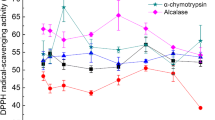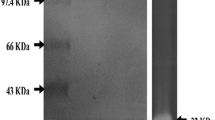Abstract
In this research, two copper-binding peptides were identified in the proteolysate of Acetes japonicus. Firstly, the examination of the effects of hydrolysis conditions including enzyme type, pH, temperature, enzyme:substrate (E:S) ratio and hydrolysis time on the copper-binding capacity (CBC) was carried out. Secondly, to optimize the hydrolysis, response surface methodology (RSM) was applied via E:S ratio and hydrolysis time for maximizing the CBC of the proteolysate. After that, the amino acid composition and functional properties of the proteolysate was evaluated. Simultaneously, before being tested for CBC, four peptide fractions of 10–30 kDa, 3–10 kDa, 1–3 kDa, and < 1 kDa were recovered from the proteolysate using ultrafiltration. Finally, mass spectrometer / mass spectrometer (MS/MS) was used to determine molecular weight and amino acid sequence of bioactive peptide. The result showed that when using Flavourzyme, pH 6, 60 °C, E:S ratio of 40.33 U/g protein and hydrolysis time of 4.15 h, CBC reached its peak at 2699.72 µgCu2+/g protein. Proteolysate, of which Leu was the major amino acid, the indispensible amino acids comprised of approximately 40% total amino acid content. The proteolysate also exerted great solubility, heat stability, foaming and emulsifying property, oil and water holding capacity (OHC and WHC, respectively). The 1–3 kDa fraction exhibited the highest CBC of 2754.73 ± 91.87 μg Cu2+/g protein, from which two peptides (Asp-Tyr-Met-Leu-Pro-Thr-Asp-Lys-Tyr-Pro-His (1378.6 Da) and Gly-Tyr-Pro-Phe-Asp-Ala-Asp-Ser-Val-Asn-Phe-Pro-Val-His-Gly (1620.7 Da)) were detected. This is the first time that the copper affinity peptides were recovered from the small shrimp that could be utilized as a natural source for copper enhancement.
Graphic Abstract











Similar content being viewed by others
References
Desai, V., Kaler, S.G.: Role of copper in human neurological disorders. Am. J. Clin. Nutr. 88, 855S–858S (2008)
Wapnir, R.A.: Copper absorption and bioavailability. Am. J. Clin. Nutr. 67, 1054S–1060S (1060S)
Harris, E.D.: Minerals in food: Nutrition, Metabolism. Bioactivity. DEStech Publications, USA (2014)
Myint, Z.W., Oo, T.H., Thein, K.Z., Tun, A.M., Saeed, H.: Copper deficiency anemia: review article. Ann. Hematol. 97, 1527–1534 (2018)
Pham, A.N., Xing, G., Miller, C.J., Waite, T.D.: Fenton-like copper redox chemistry revisited: hydrogen peroxide and superoxide mediation of copper-catalyzed oxidant production. J. Catal. 301, 54–64 (2013)
Bost, M., Houdart, S., Oberli, M., Kalonji, E., Huneau, J.-F., Margaritis, I.: Dietary copper and human health: current evidence and unresolved issues. J. Trace. Elem. Med. Biol. 35, 107–115 (2016)
Brewer, G.J.: The risks of free copper in the body and the development of useful anticopper drugs. Curr. Opin. Clin. Nutr. Metab. Care 11, 727–732 (2008)
Crisponi, G., Nurchi, V.M., Fanni, D., Gerosa, C., Nemolato, S., Faa, G.: Copper-related diseases: from chemistry to molecular pathology. Coord. Chem. Rev. 254, 876–889 (2010)
Foegeding, E.A.: Food protein functionality-a new model. J. Food Sci. 80, C2670–2677 (2015)
Noman, A., Xu, Y., AL-Bukhaiti, W.Q., Abed, S.M., Ali, A.H., Ramadhan, A.H., Xia, W.: Influence of enzymatic hydrolysis conditions on the degree of hydrolysis and functional properties of protein hydrolysate obtained from Chinese sturgeon (Acipenser sinensis) by using papain enzyme. Process Biochem. 67, 19–28 (2018)
Thiansilakul, Y., Benjakul, S., Shahidi, F.: Compositions, functional properties and antioxidative activity of protein hydrolysates prepared from round scad (Decapterus maruadsi). Food Chem. 103, 1385–1394 (2007)
AOAC: AOAC: Official methods of analysis, 15th ed. The association of official analytical chemists, Washington, DC, USA (2000)
Folch, J., Lees, M., Stanley, G.H.S.: A simple method for the isolation and purification of total lipides from animal tissues. J. Biol. Chem. 226, 497–509 (1957)
Vo, T.D.L., Pham, K.T., Le, L.T., Nguyen, T.T.H.: Identification of a new calcium-binding peptide from enzymatic proteolysate of Acetes japonicus. J Food Process Pres. 42, e13837 (2018)
Lowry, O.H., Rosebrough, N.J., Farr, A.L., Randall, R.J.: Protein measurement with the Folin phenol reagent. J Biol. Chem. 193, 265–275 (1951)
Nielsen, P.M., Petersen, D., Dambmann, C.: Improved method for determining food protein degree of hydrolysis. J. Food Sci. 66, 642–646 (2001)
Kong, B., Xiong, Y.: Antioxidant activity of zein hydrolysates in a liposome system and the possible mode of action. J. Agric. Food Chem. 54, 6059–6068 (2006)
Li, X., Luo, Y., Shen, H., You, J.: Antioxidant activities and functional properties of grass carp (Ctenopharyngodon idellus) protein hydrolysates. J. Sci. Food Agric. 92, 292–298 (2012)
Putra, S.N.K.M., Ishak, N.H., Sarbon, N.M.: Preparation and characterization of physicochemical properties of golden apple snail (Pomacea canaliculata) protein hydrolysate as affected by different proteases. Biocatal. Agric. Biotechnol. 13, 123–128 (2018)
Gbogouri, G.A., Linder, M., Fanni, J., Parmentier, M.: Influence of hydrolysis degree on the functional properties of salmon byproducts hydrolysates. J. Food Sci. 69, 615–622 (2004)
Castro, R.J.S.D., Sato, H.H.: A response surface approach on optimization of hydrolysis parameters for the production of egg white protein hydrolysates with antioxidant activities. Biocatal. Agric. Biotechnol. 4, 55–62 (2015)
He, R., Girgih, A.T., Malomo, S.A., Jud, X., Aluko, R.E.: Antioxidant activities of enzymatic rapeseed protein hydrolysates and the membrane ultrafiltration fractions. J. Funct. Foods 5, 219–227 (2013)
Kozlowski, H., Bal, W., Marcin, D., Kowalik-Jankowska, T.: Specific structure–stability relations in metallopeptides. Coord. Chem. Rev. 184, 319–346 (1999)
Shu, G., Zhang, B., Zhang, Q., Wan, H., Li, H.: Effect of temperature, pH, Enzyme to substrate ratio, substrate concentration and time on the antioxidative activity of hydrolysates from goat milk casein by alcalase acta universitatis cibiniensis series E. Food Technol. 20, 29–38 (2017)
DeLong, J.P., Gibert, J.P., Luhring, T.M., Bachman, G., Reed, B., Neyer, A., Montooth, K.L.: The combined effects of reactant kinetics and enzyme stability explain the temperature dependence of metabolic rates. Ecol. Evol. 7, 3940–3950 (2017)
Kang, P.Y., Ishak, N.H., Sarbon, N.M.: Optimization of enzymatic hydrolysis of shortfn scad (Decapterus macrosoma) myofbrillar protein with antioxidant effect using alcalase. Int. Food Res. J. 25, 1808–1817 (2018)
Chen, D., Mu, X., Huang, H., Nie, R., Liu, Z., Zeng, M.: Isolation of a calcium-binding peptide from tilapia scale protein hydrolysate and its calcium bioavailability in rats. J. Funct. Foods 6, 575–584 (2014)
Liu, Q., Kong, B., Xiong, Y.L., Xia, X.: Antioxidant activity and functional properties of porcine plasma protein hydrolysate as influenced by the degree of hydrolysis. Food Chem. 118, 403–410 (2010)
Merz, M., Ewert, J., Baur, C., Appel, D., Blank, I., Stressler, T., Fischer, L.: Wheat gluten hydrolysis using isolated Flavourzyme peptidases: product inhibition and determination of synergistic effects using response surface methodology. J. Mol. Catal. B Enzym. 122, 218–226 (2015)
Bal, W., Chmurny, G.N., Hilton, B.D., Sadler, P.J., Tucker, A.: Axial hydrophobic fence in highly-stable ni(II) complex of des-angiotensinogen N-terminal peptide. J. Am. Chem. Soc. 118, 4727–4728 (1996)
Łodyga-Chruscinska, E.: Tetrazole peptides as copper(II) ion chelators. Coord. Chem. Rev 255, 1824–1833 (2011)
Sóvágó, I., Kállay, C., Várnagy, K.: Peptides as complexing agents: factors influencing the structure and thermodynamic stability of peptide complexes. Coord. Chem. Rev. 256, 2225–2233 (2012)
Radomska B, Sovago l, Kiss T: Tyrosinate and Lysinate as Bridging Residues in Copper (II) Dipeptide Complexe. 1, 289–292 (1990)
Mendola, D.L., Magrì, A., Santoro, A.M., Nicoletti, V.G., Rizzarelli, E.: Copper(II) interaction with peptide fragments of histidine–proline-rich glycoprotein: speciation, stability and binding details. J. Inorg. Biochem. 111, 59–69 (2012)
Kristinsson, H.G., Rasco, B.A.: Biochemical And Functional Properties Of Atlantic Salmon (Salmo salar) muscle proteins hydrolyzed with various alkaline proteases. J. Agric. Food Chem. 48, 657–666 (2000)
Ktari, N., Jridi, M., Bkhairia, I., Sayari, N., Salah, R.B., Nasri, M.: Functionalities and antioxidant properties of protein hydrolysates from muscle of zebra blenny (Salaria basilisca) obtained with different crude protease extracts. Food Res. Int. 49, 747–756 (2012)
Zayas, J.F.: Functionality of proteins in food. Springer, Berlin, Heidelberg, Germany (1997)
Nurdiani, R., Dissanayake, M., Street, W.E., Donkor, O.N., Singh, T.K., Vasiljevic, T.: In vitro study of selected physiological and physicochemical properties of fish protein hydrolysates from 4 Australian fish species. Int. Food Res. J. 23, 2029–2040 (2016)
Intarasirisawat, R., Benjakul, S., Visessanguan, W., Wu, J.: Antioxidative and functional properties of protein hydrolysate from defatted skipjack (Katsuwonous pelamis) roe. Food Chem. 135, 3039–3048 (2012)
Kitabatake, N., Doi, E.: Surface tension and foaming of protein solutions. J. Food Sci. 47, 1218–1221 (1982)
Naqash, S.Y., Nazeer, R.A.: Antioxidant and functional properties of protein hydrolysates from pink perch (Nemipterus japonicus) muscle. J. Food Sci. Technol. 50, 972–978 (2013)
Li, Z., Wang, B., Chi, C., Gong, Y., Luo, H., Ding, G.: Influence of average molecular weight on antioxidant and functional properties of cartilage collagen hydrolysates from Sphyrna lewini, Dasyatis akjei and Raja porosa. Food Res. Int. 51, 283–293 (2013)
Pacheco-Aguilar, R., Mazorra-Manzano, M.A., Ramírez-Suárez, J.C.: Functional properties of fish protein hydrolysates from Pacific whiting (Merluccius productus) muscle produced by a commercial protease. Food Chem. 109, 782–789 (2008)
Latorres, J.M., Rios, D.G., Saggiomo, G., Wasielesky Jr., W., Prentice-Hernandez, C.: Functional and antioxidant properties of protein hydrolysates obtained from white shrimp (Litopenaeus vannamei). J. Food Sci. Technol. 55, 721–729 (2018)
Santos, S.D.A.D., Martins, V.G., Salas-Mellado, M., Prentice, C.: Evaluation of Functional properties in protein hydrolysates from bluewing searobin (Prionotus punctatus) obtained with different microbial enzymes. Food Bioprocess Technol. 4, 1399–1406 (2011)
Cumby, N., Zhong, Y., Naczk, M., Shahidi, F.: Antioxidant activity and water-holding capacity of canola protein hydrolysates. Food Chem. 109, 144–148 (2008)
Foh, M.B.K., Kamara, M.T., Amadou, I., Foh, B.M., Wenshui, X.: Chemical and physicochemical properties of tilapia (Oreochromis niloticus) fish protein hydrolysate and concentrate. Int. J. Biol. Chem. 5, 21–36 (2011)
Matera-Witkiewicz, A., Jolanta, J.B., S´wiatek-Kozłowska Pratesi, A., Ginanneschi, M., Messori, L.: Short-chain oligopeptides with copper(II) binding properties: the impact of specific structural modifications on the copper(II) coordination abilities. J. Inorg. Biochem. 103, 678–688 (2009)
Acknowledgements
This research is funded by Vietnam National Foundation for Science and Technology Development (NAFOSTED) under grant number 106-NN.02-2016.62.
Author information
Authors and Affiliations
Corresponding author
Additional information
Publisher's Note
Springer Nature remains neutral with regard to jurisdictional claims in published maps and institutional affiliations.
Rights and permissions
About this article
Cite this article
Vo, T.D.L., Pham, K.T. & Doan, K.T. Identification of Copper-Binding Peptides and Investigation of Functional Properties of Acetes japonicus Proteolysate. Waste Biomass Valor 12, 1565–1579 (2021). https://doi.org/10.1007/s12649-020-01112-3
Received:
Accepted:
Published:
Issue Date:
DOI: https://doi.org/10.1007/s12649-020-01112-3




